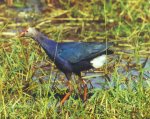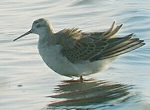
Birdwatching

The Algarve has an immense variety of indigenous birds and migrants. In the garden at Casa Martin you are likely to see all manner of tits, finches, cuckoos, woodpeckers, hoopoe, egrets, martins, little owls, azure winged magpies, bee-eaters, robins and many others. Please let us know if you see something distinctive. The Griffin Bookshop in Almancil usually has local guides.
 There
are facilities for birdwatching in the Ria Formosa National Park and at
Ludo as well as the reserves at Castro Marim. The only purple gallinule
in Portugal can often be spotted in the lake on the golf course from the
hide There are likely to be storks wherever there are chimneys. The coasts
are teeming with all manner of gulls, terms, waders, flamingos, herons
etc whereas the inland areas are good for spotting raptors. Usually waxbills
which are locally common from escaped cage bird stock can be seen on the
greens and tees of the golf course.
There
are facilities for birdwatching in the Ria Formosa National Park and at
Ludo as well as the reserves at Castro Marim. The only purple gallinule
in Portugal can often be spotted in the lake on the golf course from the
hide There are likely to be storks wherever there are chimneys. The coasts
are teeming with all manner of gulls, terms, waders, flamingos, herons
etc whereas the inland areas are good for spotting raptors. Usually waxbills
which are locally common from escaped cage bird stock can be seen on the
greens and tees of the golf course.
The Ria Formosa is the most important birding site in the Algarve despite being one of the most popular of the area's tourist destinations. There has been loss of habitat to development but the area still has excellent birdwatching. The Ria Formosa is of great importance for a wide range of breeding, passage and wintering birds.
 Little
Bittern and Purple Heron both breed as well as egrets, White Stork and
Stone Curlew. Collared Pratincole used to breed in the area but they have
become much rarer in recent years. Little Tern breeds in important numbers
on some of the islands and the Ludo Farm and Quinta do Lago in the west
of the area have breeding Purple Gallinule and Red-crested Pochard. Golden
Oriole, Dartford Warbler and Short-toed Lark are also common breeders
in the area and Azure-winged Magpie and Short-toed Treecreeper can be
seen in Stone Pine woodlands.
Little
Bittern and Purple Heron both breed as well as egrets, White Stork and
Stone Curlew. Collared Pratincole used to breed in the area but they have
become much rarer in recent years. Little Tern breeds in important numbers
on some of the islands and the Ludo Farm and Quinta do Lago in the west
of the area have breeding Purple Gallinule and Red-crested Pochard. Golden
Oriole, Dartford Warbler and Short-toed Lark are also common breeders
in the area and Azure-winged Magpie and Short-toed Treecreeper can be
seen in Stone Pine woodlands.
The greatest diversity of species occurs during passage periods with spring seeing the arrival of Great Spotted Cuckoo and passerines including Redstart, Whinchat, Black-eared Wheatear, and warblers such as Spectacled and Subalpine. A wider range of passerine migrants occurs in autumn when Tawny Pipit, Bluethroat, Pied Flycatcher and various warblers. Little Stint, Curlew Sandpiper, Ruff and Spotted Redshank are among the many species of wader to be seen here in autumn, Black Tern is regular and raptors such as Red Kite, Short-toed and Booted Eagle pass through.
 In
winter Black-necked Grebe, Greater Flamingo, Glossy Ibis and Spoonbill
are regular as well as Caspian Tern and waders including Black-winged
Stilt. Large numbers of waterfowl winter here and in excess of 10,000
ducks can be seen including Wigeon, Teal, Gadwall and Pintail. Passerines
in winter include Water Pipit, Bluethroat and Penduline Tit.
In
winter Black-necked Grebe, Greater Flamingo, Glossy Ibis and Spoonbill
are regular as well as Caspian Tern and waders including Black-winged
Stilt. Large numbers of waterfowl winter here and in excess of 10,000
ducks can be seen including Wigeon, Teal, Gadwall and Pintail. Passerines
in winter include Water Pipit, Bluethroat and Penduline Tit.
Rarer species recorded in the Ria Formosa area include Bean Goose, Blue-winged Teal, Long-tailed Duck, White-headed and Ruddy Ducks, Marbled Duck and Crested Coot. A Wilson's Phalarope was present in September 2002.
 At
the ETAR waterworks at Montenegro there is a large lake worth looking
at, to reach it leave Faro west on the N125 veering left towards the airport
after 3km and turning left 1km later following signs for Montenegro. Continue
over the crossroads and head south, veering left then right and the lake
can then be seen on the left. Further on are saltpans, saltmarsh and mudflats.
For Ludo Farm return to the N125 and continue westwards for a further
700m before turning right onto a rough track. Along this track are pines
and scrub, saltpans and pools and the entire area is excellent birding
country.
At
the ETAR waterworks at Montenegro there is a large lake worth looking
at, to reach it leave Faro west on the N125 veering left towards the airport
after 3km and turning left 1km later following signs for Montenegro. Continue
over the crossroads and head south, veering left then right and the lake
can then be seen on the left. Further on are saltpans, saltmarsh and mudflats.
For Ludo Farm return to the N125 and continue westwards for a further
700m before turning right onto a rough track. Along this track are pines
and scrub, saltpans and pools and the entire area is excellent birding
country.
To the east of Faro is the Ria Formosa park headquarters at Quinta do Marim, take the N125 east to Olhao and turn right just before petrol station on the other side of the town. Cross the railway line and a track to the left leads to the entrance where a small fee is payable. There is a nature trail here, farmland and saltpans.